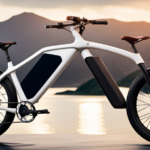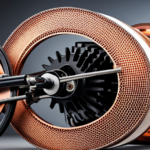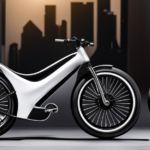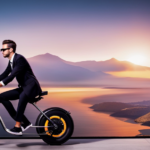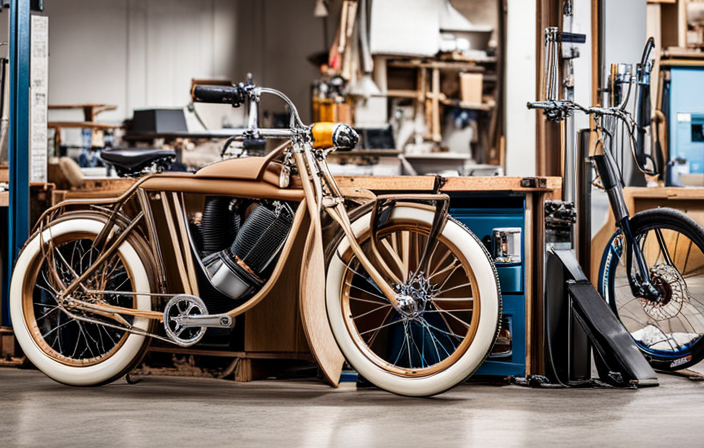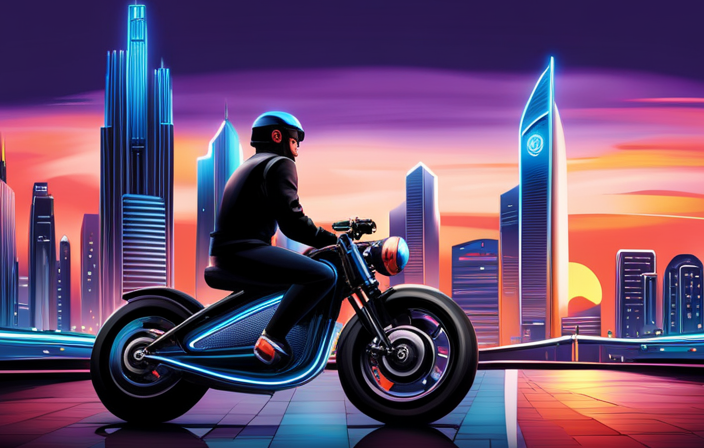What is the significance of watts on an electric bicycle?
As an avid cyclist and electric bike enthusiast, I’ve often wondered about the significance of watts in the world of electric bikes. In this article, I will delve into the technical aspects and provide detailed information on how watts affect the speed, performance, and battery life of an electric bike.
Additionally, I will discuss the benefits of higher wattage motors for commuting and long-distance riding. Let’s explore the relationship between watts and torque in electric bike motors and debunk common misconceptions along the way.
So, let’s get started and discover how to choose the right wattage for your riding needs.
Key Takeaways
- Watts are a unit of power measurement in electric bikes.
- Higher wattage motors provide more assistance and higher speeds.
- Higher wattage motors consume more power and drain the battery faster.
- Choosing the right wattage for your riding needs is important for optimal performance.
Definition of Watts in the Context of Electric Bikes
Do you know what watts mean on an electric bike? Watts are a unit of power measurement, and they play a crucial role in understanding power consumption and the impact of wattage on battery efficiency.
When it comes to electric bikes, watts refer to the amount of power the motor can generate. This power determines how fast and how far the bike can go.
Understanding power consumption is essential because it directly affects the battery life of an electric bike. Higher wattage motors generally consume more power, leading to faster battery drain. On the other hand, lower wattage motors are more energy-efficient, allowing for longer rides before needing to recharge. It’s important to find the right balance between power and battery efficiency based on your specific needs and riding style.
The impact of wattage on battery efficiency cannot be overlooked. A higher wattage motor may provide more speed and acceleration, but it will drain the battery faster. Conversely, a lower wattage motor may not offer the same level of performance but can provide a longer battery life. Therefore, it’s crucial to consider your intended usage and prioritize either power or battery efficiency.
Understanding the power output of electric bike motors is the next step in maximizing your riding experience.
Understanding the Power Output of Electric Bike Motors
Understanding the power output of e-bike motors can help riders determine the level of assistance they can expect while riding. The wattage of an electric bike motor directly impacts its performance and the rider’s overall experience.
Here are some key points to consider when it comes to understanding the power output of e-bike motors:
-
Wattage Impact
-
The wattage of an e-bike motor refers to the amount of power it can produce. Higher wattage motors generally provide more assistance and are capable of propelling the bike at higher speeds.
-
A higher wattage motor can handle steeper inclines and provide a stronger boost when accelerating. This is particularly important for riders who frequently encounter hilly terrains or require additional assistance.
-
On the other hand, a lower wattage motor may be suitable for riders who prefer a more subtle level of assistance or primarily ride on flat surfaces.
-
Wattage Selection
-
When selecting an electric bike, it’s important to consider your specific needs and preferences. Assessing the terrain you’ll be riding on and the level of assistance you desire can help determine the appropriate wattage for your motor.
-
Riders who frequently tackle challenging terrains or require a powerful boost should opt for a higher wattage motor, typically ranging from 500 to 750 watts.
-
For riders who mainly ride on flat surfaces or prefer a more moderate level of assistance, a motor with a wattage between 250 and 500 watts may be sufficient.
Understanding the power output of e-bike motors is crucial in making an informed decision when selecting an electric bike. The wattage impact and wattage selection play a vital role in determining the level of assistance and overall performance you can expect from your e-bike.
In the next section, we will explore how watts affect the speed and performance of an electric bike without skipping a beat.
How Watts Affect the Speed and Performance of an Electric Bike
The speed and performance of an e-bike are directly impacted by the amount of power its motor can produce. The power output of an e-bike motor is measured in watts. Watts represent the rate at which the motor can generate energy or do work. In the context of an electric bike, higher wattage motors generally result in faster acceleration, higher top speeds, and better overall performance.
However, it is important to consider the effect of watts on the lifespan of the battery and the wear and tear of the motor. Higher wattage motors tend to draw more power from the battery, which can lead to a shorter battery lifespan. Additionally, the increased power output puts more strain on the motor components, potentially causing them to wear out faster.
Finding the right balance between power and efficiency is crucial. It is important to choose an e-bike with a motor that has sufficient wattage to meet your performance needs while also considering the impact on the battery lifespan and motor durability.
Transitioning into the subsequent section about the relationship between watts and battery life, it is essential to understand how the power output of an e-bike motor can affect the longevity of the battery.
The Relationship Between Watts and Battery Life
To maximize the lifespan of your battery, it’s important to consider how the power output of your e-bike motor can impact its longevity. The relationship between watts and battery life is crucial to understand when choosing an electric bike. Battery capacity, efficiency, and wattage are all factors that play a role in determining how long your battery will last.
Battery capacity refers to the amount of energy that can be stored in the battery. This is typically measured in watt-hours (Wh). The higher the battery capacity, the more energy it can store, which means you can ride for longer periods before needing to recharge.
Efficiency is another important factor to consider. It refers to how effectively the motor converts electrical energy into mechanical power. A more efficient motor will require less energy from the battery, resulting in a longer battery life.
Lastly, wattage is the power output of the motor. It determines how much power the motor can deliver to the bike. Higher wattage motors can provide more speed and acceleration, but they also consume more energy from the battery.
In summary, when choosing an electric bike, it’s essential to consider battery capacity, efficiency, and wattage. These factors will impact the lifespan of your battery and determine how long you can ride before needing to recharge.
Now let’s delve into the next section about choosing the right wattage for your riding needs.
Choosing the Right Wattage for Your Riding Needs
When selecting an e-bike, it’s crucial to choose the appropriate wattage for your riding preferences. The wattage of an electric bike refers to the power output of its motor. It determines the speed and performance of the bike, making it an important factor to consider.
One key consideration when choosing the right wattage is terrain compatibility. If you plan to ride on hilly or challenging terrains, a higher wattage motor will provide you with the necessary power to conquer those inclines effortlessly. On the other hand, if you mainly ride on flat surfaces or have a lighter weight, a lower wattage motor may be sufficient for your needs.
Weight capacity is another important factor to consider when selecting the appropriate wattage for your e-bike. If you are a heavier rider or plan to carry heavy loads, opting for a higher wattage motor is advisable. It will ensure that the motor can handle the additional weight without compromising performance or straining the motor.
Now, let’s delve into the difference between hub motors and mid-drive motors in terms of watts.
The Difference Between Hub Motors and Mid-Drive Motors in Terms of Watts
If you’re comparing hub motors and mid-drive motors, you’ll find that the power output is distributed differently. When it comes to electric bike motors, understanding the difference in power distribution is crucial in making an informed decision. Here’s what you need to know:
-
Hub Motor Efficiency: Hub motors are located in the center of the wheel, providing direct power to it. This design allows for efficient power transfer, as there are no additional gears or chains involved. However, hub motors tend to have a fixed gear ratio, limiting their ability to optimize power output for different riding conditions.
-
Mid-Drive Motor Power Distribution: Mid-drive motors are positioned near the bike’s bottom bracket, leveraging the bike’s gears to distribute power. This design allows for better power distribution, especially on hilly terrains or when riding at higher speeds. By utilizing the bike’s gears, mid-drive motors can provide more torque and better efficiency in various riding scenarios.
-
Enhanced Climbing Ability: Due to their power distribution through the bike’s gears, mid-drive motors excel in climbing steep hills. The ability to leverage lower gear ratios results in improved torque, making it easier to conquer challenging terrains with less strain on the motor.
-
Balanced Weight Distribution: With the motor positioned in the center of the bike, mid-drive motors offer better weight distribution. This balance allows for improved handling and maneuverability, making them ideal for off-road and mountain biking.
Understanding the difference in power distribution between hub motors and mid-drive motors is essential in choosing the right motor for your electric bike. However, there are other factors that can impact the efficiency of an electric bike’s motor, which we will explore in the next section.
Factors that Can Impact the Efficiency of an Electric Bike’s Motor
One of the factors that can affect the efficiency of an e-bike’s motor is the type of terrain it is being ridden on. The impact of terrain on motor performance is significant and should not be overlooked. When riding on flat, smooth surfaces, the motor can operate at its maximum efficiency, providing optimal power output. However, when faced with uphill climbs or rough, uneven terrains, the motor has to work harder, resulting in decreased efficiency.
The incline of the terrain is one of the primary factors that affect motor efficiency. Uphill climbs require the motor to exert more power to overcome gravity, reducing its overall efficiency. Similarly, riding on rough terrains, such as gravel or dirt paths, can cause increased friction between the tires and the ground, further decreasing motor efficiency.
Additionally, wind resistance can also impact motor performance. Riding against strong headwinds requires the motor to work harder to maintain speed, resulting in reduced efficiency.
Understanding these factors and their impact on motor performance is crucial for e-bike riders. By choosing appropriate riding routes and adjusting their riding style to accommodate for the terrain, riders can optimize their motor’s efficiency and extend their battery life.
Now, let’s delve into how to calculate the watt-hours of an electric bike’s battery.
How to Calculate the Watt-Hours of an Electric Bike’s Battery
Calculating the watt-hours of an e-bike’s battery can be done by multiplying the voltage of the battery by the amp-hours it can deliver. This calculation is essential for estimating the battery range and understanding the power consumption of your electric bike. To give you a better understanding, let’s use a 48V battery with a capacity of 10Ah as an example.
| Voltage (V) | Amp-Hours (Ah) |
|---|---|
| 48 | 10 |
To calculate the watt-hours, we simply multiply the voltage (48V) by the amp-hours (10Ah):
48V x 10Ah = 480 watt-hours
This means that the battery can deliver 480 watt-hours of energy. By knowing the watt-hours of your battery, you can estimate how far you can travel before the battery requires recharging.
Understanding the watt-hours of your e-bike’s battery is crucial, especially when it comes to uphill climbing and off-road riding. Higher watt-hours mean a greater capacity to deliver power, allowing you to tackle steeper inclines and rough terrains. In the next section, we will explore the importance of watts in uphill climbing and off-road riding, highlighting how it affects the performance and capabilities of your electric bike.
The Importance of Watts in Uphill Climbing and Off-Road Riding
Understanding the significance of watts in uphill climbing and off-road riding is crucial for maximizing your e-bike’s performance and capabilities. When facing uphill challenges, the wattage of your electric bike plays a key role in determining how well it can conquer the incline and maintain speed. Here are three ways in which watts impact your e-bike’s uphill performance:
-
Power output: A higher wattage motor provides greater power output, allowing you to tackle steeper hills with ease. More watts mean more torque, enabling your e-bike to maintain a steady pace uphill and overcome any obstacles along the way.
-
Battery efficiency: Uphill riding consumes more energy due to increased resistance and effort required. With higher wattage, your e-bike’s battery will be utilized more efficiently, ensuring longer rides and minimizing the risk of running out of power halfway through your journey.
-
Handling off-road obstacles: Off-road riding often presents challenging terrains like rocks, roots, and uneven surfaces. A higher wattage motor offers better acceleration and control, allowing you to navigate through these obstacles smoothly and safely.
By understanding the importance of watts in uphill climbing and off-road riding, you can choose an e-bike with the appropriate wattage to overcome uphill challenges and conquer off-road obstacles.
Now, let’s explore how wattage can determine the range of an electric bike without writing ‘step’.
How Wattage Can Determine the Range of an Electric Bike
To determine the range of your e-bike, you’ll need to consider the wattage of the motor and its impact on battery efficiency. Calculating wattage is crucial in understanding how far your electric bike can travel on a single charge.
The wattage of the motor directly affects the power output and energy consumption of your e-bike. A higher wattage motor will provide more power, allowing you to tackle steeper terrain or ride at faster speeds. However, it’s important to note that higher wattage motors can also drain the battery faster, reducing the overall range.
In addition to motor wattage, the impact of terrain should also be taken into account when determining the range of your e-bike. Riding on hilly terrain or off-road trails requires more power from the motor, which can significantly reduce the battery life. Uphill climbs, for instance, require the motor to work harder, drawing more energy from the battery and reducing the overall range. Similarly, riding on rough terrain or in adverse weather conditions can also increase power consumption, further affecting the range of your e-bike.
Understanding the relationship between wattage, battery efficiency, and terrain is crucial for accurately estimating the range of your electric bike. By considering these factors, you can plan your rides and manage your battery usage more effectively.
Now, let’s explore the role of watts in electric bike regulations and laws.
The Role of Watts in Electric Bike Regulations and Laws
When it comes to electric bike regulations and laws, you’ll want to know how wattage factors into the equation. Understanding the power limits and legal requirements surrounding electric bikes is crucial to ensure you are riding within the law. Here are a few important things to know:
- Different countries and states have varying regulations regarding the maximum wattage allowed for electric bikes.
- In some places, electric bikes with a motor wattage above a certain limit may be classified as motorcycles and require additional licenses and registrations.
- Most jurisdictions set a power limit of 750 watts for electric bikes to be considered as bicycles, allowing riders to enjoy the benefits of electric assistance without the need for special permits.
- It is important to check the specific regulations in your area to ensure that your electric bike complies with the legal requirements.
Understanding the legal requirements for electric bike wattage will help you stay on the right side of the law and avoid any potential penalties.
Now, let’s explore the benefits of higher wattage motors for commuting and long-distance riding.
The Benefits of Higher Wattage Motors for Commuting and Long-Distance Riding
If you want a more powerful motor for commuting and long-distance riding, higher wattage motors can provide the extra boost you need. When it comes to electric bike motors, the wattage rating plays a crucial role in determining the performance capabilities of the motor. Higher wattage motors generally offer greater acceleration and hill-climbing abilities compared to lower wattage motors.
To understand the impact of wattage on electric bike performance, let’s compare the characteristics of higher and lower wattage motors in the table below:
| Wattage (W) | Acceleration | Hill Climbing |
|---|---|---|
| Higher | Faster | Easier |
| Lower | Slower | Harder |
As the table shows, higher wattage motors provide faster acceleration and make it easier to climb hills. This is because higher wattage motors can deliver more power to the wheels, resulting in increased torque and speed. On the other hand, lower wattage motors may struggle to provide sufficient power for quick acceleration and may require more effort to tackle steep inclines.
The Relationship Between Watts and Torque in Electric Bike Motors
The relationship between wattage and torque in e-bike motors can greatly impact the overall performance. When it comes to electric bikes, watts are a measure of power output. The higher the wattage of the motor, the more power it can deliver to the wheels. This directly affects the acceleration of the bike. A higher wattage motor will provide more torque, allowing for faster acceleration and better climbing ability. This is especially important for riders who frequently encounter steep hills or need to quickly accelerate in traffic.
In addition to acceleration, the wattage of the motor also has an impact on its longevity. Higher wattage motors tend to be more robust and durable, as they are designed to handle the increased power demands. This means that they are less likely to overheat or burn out when put under heavy load, ensuring a longer lifespan for the motor.
It’s important to note that while wattage is a crucial factor in determining the performance and durability of an electric bike motor, it’s not the only factor. Factors such as motor design, battery capacity, and overall bike weight also play a significant role. Understanding the relationship between wattage and torque is just one piece of the puzzle when it comes to choosing the right electric bike for your needs.
Moving on to common misconceptions about watts and electric bikes…
Common Misconceptions About Watts and Electric Bikes
One common misconception is that higher wattage always means better performance. However, this belief is not entirely accurate when it comes to electric bikes. There are several misconceptions about electric bike power that need to be debunked in order to make an informed decision when choosing an electric bike.
Firstly, it is important to understand that wattage refers to the power output of an electric bike motor. Higher wattage does not necessarily translate to better performance. The performance of an electric bike is determined by a combination of factors, including the motor’s torque, battery capacity, and overall design.
Another misconception is that higher wattage always means faster speeds. While it is true that higher wattage can potentially provide more power, other factors such as weight, terrain, and rider input also play a significant role in determining the top speed of an electric bike.
In addition, some people believe that higher wattage means longer battery life. However, this is not always the case. The battery capacity and efficiency of the motor are the primary factors that determine the range of an electric bike, not just the wattage.
Tips for Choosing an Electric Bike with the Right Wattage for Your Needs
When selecting an e-bike, it’s essential to consider your specific needs and find the right wattage. Choosing the appropriate wattage for your electric bike is crucial because it directly impacts the performance and efficiency of the motor.
The wattage of an e-bike refers to the power output of its motor. The higher the wattage, the more power the motor can generate, resulting in faster acceleration and greater speed. However, it’s important to note that higher wattage also means increased energy consumption, which can affect the range of the bike.
To choose the right wattage for your e-bike, you need to consider your intended use and terrain. If you plan on using your electric bike for commuting on flat surfaces, a lower wattage motor, such as 250-500 watts, may be sufficient. On the other hand, if you anticipate riding on hilly terrain or carrying heavy loads, you may want to consider a higher wattage motor, such as 750-1000 watts, for better performance.
Another factor to consider when choosing wattage is motor efficiency. A more efficient motor will convert a higher percentage of energy into power, resulting in improved performance and longer battery life. Look for e-bikes with motors that have high efficiency ratings to ensure you get the most out of your wattage.
Frequently Asked Questions
Can I increase the wattage of my electric bike motor to improve its performance?
Yes, you can increase the wattage of your electric bike motor to enhance its performance. By increasing the motor power, you can achieve improvements such as increased speed, quicker acceleration, and improved hill-climbing abilities.
However, it is important to note that modifying the wattage of your electric bike motor may require technical expertise and could potentially void any warranties. It is advisable to consult with a professional or the manufacturer before making any modifications.
Are there any legal restrictions on the wattage of electric bike motors?
There are indeed legal restrictions on the wattage of electric bike motors. These restrictions vary by country and region.
It is important to understand and comply with these regulations to ensure the legal operation of your electric bike. While some jurisdictions have specific wattage limits, others may regulate the top speed or require certain safety features.
It is important to consult local laws and regulations to determine the legal wattage limit for your electric bike.
How do watts and torque work together to affect the performance of an electric bike?
When considering the performance of an electric bike, the electric bike motor power, measured in watts, plays a significant role. However, it is the torque, the rotational force produced by the motor, that truly determines the bike’s ability to accelerate and climb hills.
While wattage indicates the motor’s overall power, torque is crucial for achieving high performance. A motor with higher torque will provide better acceleration and hill-climbing capabilities, making it an important factor to consider when choosing an electric bike.
What are some common misconceptions about the relationship between watts and electric bikes?
When it comes to understanding power in electric bikes, there are several common misconceptions that need to be addressed.
One such misconception is that the higher the wattage, the faster the bike will go. While wattage does play a role in determining speed, it is not the sole factor.
Other factors, such as torque and gear ratios, also contribute to the overall performance of an electric bike. Therefore, it is important to consider all aspects of the bike’s power system to accurately gauge its capabilities.
What factors should I consider when choosing the right wattage for my electric bike?
When choosing the right wattage for an electric bike, several factors should be considered.
Firstly, battery capacity plays a crucial role in determining the power output of the bike. A higher wattage motor requires a larger battery capacity to ensure sufficient power supply.
Secondly, weight distribution is important as a heavier bike may require a higher wattage motor to provide adequate assistance.
Evaluating these factors will help you select the appropriate wattage for your electric bike.
Conclusion
In conclusion, understanding the concept of watts in the context of electric bikes is crucial for making an informed decision when purchasing one. The power output of electric bike motors, measured in watts, directly affects the speed, performance, and battery life of the bike.
By choosing the right wattage for your riding needs, you can ensure optimal efficiency and enjoyment. Higher wattage motors are particularly beneficial for commuting and long-distance riding, offering increased power and torque.
Don’t fall for common misconceptions about watts and electric bikes. Instead, follow these tips to choose an electric bike with the right wattage for your needs.


